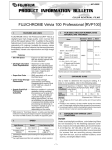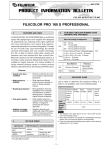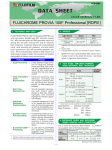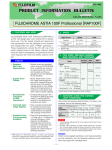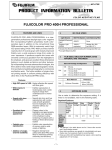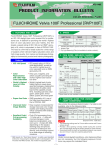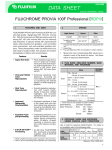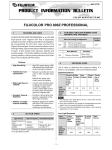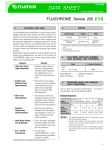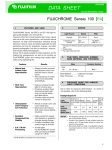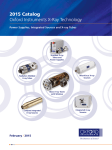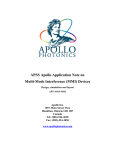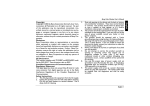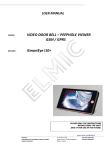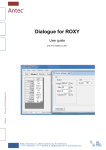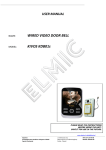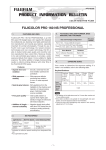Download Fujifilm Fujichrome T64
Transcript
AF3-178E COLOR REVERSAL FILMS FUJICHROME T64 Professional [RTP] 1. FEATURES AND USES 2. FUJICHROME T64 Professional [RTP] is an ISO 64 tungsten-type high-image-quality color reversal film. In its speed class, this new film provides one of the highest levels of fine grain possible and faithful color reproduction. It also provides rich gradation and well-controlled gray balance. These qualities make RTP particularly suited to all types of product photography, interior and other architectural work, as well as the reproduction of illustrations, paintings etc. SPEED Light Source Speed Color Balancing Filter Tungsten (3200K) ISO 64/19° None Electronic Flash ISO 32/16°* No. 85B** *Indicates the effective speed resulting from designated filter use. ** Wratten filter 3. FILM SIZES, EMULSION NUMBER, BASE MATERIAL AND THICKNESS Features • Smooth Gradation ... Rich, natural tones and wellcontrolled gray balance are achieved from the highlights to the shadows, resulting in the accurate reproduction of subtle gradation sought after in tungsten photography. .......... • Superb Color Multi-Color-Correcting Layer Fidelity technology, first commercialized in ASTIA100F and Velvia100F, and new-generation couplers are incorporated in this film to realize one of the world’s highest levels of hue fidelity, including delicate colors beyond the reach of existing films, making this film most suitable for the stringent color reproduction demands of commercial photography and the photographing of painting and other artwork. • Color Image ............. Use of new-generation couplers Permanence producing vastly improved color image stability and color-fading resistance compared with the current RTPII. • Ultrafine grain ......... One of the highest levels of fine quality grain with an RMS value of 7, resulting in ultrafine grain that exhibits its most impressive effect in the expression of delicate textures sought after in tungsten photography. • Superb Push/Pull .... Minimum variation in color and Processing gradation during push/pull Suitability processing over a range from –1/2 to +1 stop, providing an expanded range of phototaking opportunities, as well as facilitating fine adjustments in exposure and density during processing. Emulsion Number Size and Package Configuration 135 ... 36-exp. 35mm x 30.5 (100ft) Roll* 120 ... 12-exp. ... 12-exp. (5-roll pack) 4 x 5 in. (10 and 50 sheets) Sheet* 8 x10 in. (10 sheets) QuickLoad 4 x 5in. 751– Base Material Thickness 135 Cellulose Triacetate 127µm 120 Cellulose Triacetate Sheet Polyester 98µm 175µm *Some sizes are not available in certain markets. 4. EXPOSURE GUIDE FOR VARIOUS LIGHT CONDITIONS This film is designed to render optimum results with photographic tungsten lighting. If used under different light sources, the following color compensation and exposure correction are required. Compensations for Various Light Sources Light Sources Color Compensating Exposure Filters Corrections** Tungsten Photographic Lamps • Studio Tungsten Lamps • Tungsten-halogen Lamps • Photoflood Lamps • Photospot Lamps (Color Temperature: 3100K) None None • Daylight • Electronic Flash • Blue Photoflood Lamps • Blue Photospot Lamps (Color Temperature: 5500K) No. 85B* + 2/3 stop *Wratten Filter ** Exposure correction values include filter exposure factors. “+”followed by number = required increase in lens opening. –1– FUJIFILM PRODUCT INFORMATION BULLETIN • FUJICHROME T64 Professional [RTP] Tungsten Lamps 6. UNPROCESSED FILM HANDLING/STORAGE • Photographic tungsten lamps should be used at their specified voltages because any deviation from the correct voltage affects the color temperature. As light output and color temperature vary with manufacturer, total time the lamp has been used, line voltage, reflector and diffuser, etc. employed, test exposures are recommended. • Since household tungsten lamps have generally low color temperatures (around 2700K), No. 82A lightbalancing filters should be used if these lamps constitute the main light source. HANDLING Fluorescent lamps are not recommended for use with tungsten-type film. Under fluorescent lighting, it is advisable to use daylight-type film, along with the appropriate filters. • Expose film before the expiration date indicated on the film package and process as soon as possible after exposure. • Roll film should be loaded and unloaded quickly and away from direct sunlight. • Film loaded in cameras should be exposed and processed promptly. • Sheet film must be handled in total darkness and with care so as not to touch the emulsion surface. • X-ray inspection machines used to inspect checkedin baggage at airports can cause fogging of film. Put both exposed and unexposed film into carry-on baggage (preferably in a transparent plastic bag or a net bag that allows the film to be seen). Because of the increasing number of airports using strong X-ray machines for carry-on baggage, it is recommended that you remove film from your carry-on baggage and request a visual (manual) inspection of your film. • Film fogging may occur near X-ray equipment used in hospitals, factories, laboratories and other places where radiation is used. Always keep film away from sources of radiation. Mixed Light Sources STORAGE Under mixed light conditions, the basic filter configuration should suit the main light source. In the case of cameras with TTL metering, there is no need for addirional exposure compensation for any CC filter(s) used. Storing exposed or unexposed film under hot and humid conditions may adversely affect the speed, color balance and physical properties of the film. Although it is best to store film at a low temperature, for practical purposes, film should be stored as follows: Daylight Daylight and general electronic flash exposures require the compensations listed in the foregoing table. Exposures made under bright sun or clear blue sky conditions, where the color temperature is higher, will require the use of No. 85B + No. 81A filters. Fluorescent Lamps 5. SHORT/ LONG EXPOSURE COMPENSATION Short-term Store at 15°C or below Storage For exposures of up to 1/125 second to 2 minutes, no exposure compensation or color balance corrections are needed. Exposures longer than 4 minutes are subject to reciprocity law failure and thus require the exposure and color balance corrections. Long-term Storage • New building materials, newly manufactured furniture, paints and bonding agents may produce gases which could affect photographic film. Do not store film, lightproof boxes containing film or cameras or film holders loaded with film near these materials. • Film should be sealed in plastic bags* prior to cold storage When taken out of cold storage, film should be allowed to reach room temperature before opening by letting it stand over 3 hours (for refrigerated film) or over 6 hours (for frozen film). Opening film while it is still cold may cause condensation to form on the film surface, causing color changes or the emulsion to become more susceptible to scratches. Exposure Compensation Table Exposure Time 1/4000~ 1/250 (sec) Color Compensating Filter Not Exposure Correction Recomended (Lens Opening) 1/125 (sec) ~2 (minutes) 4 (minutes) None None None +1/3 Store at 0°C or below * Exposure correction values include filter exposure factors. “+”followed by number = required increase in lens opening. Note : The above figures are based on the use of standard processing for films with average emulsions. These figures should therefore be used as a rough guide only. For more accurate results, it is recommended that test exposures be made under the actual shooting conditions. * Polyester, polystyrene, polyethylene, polypropylene, etc. –2– FUJICHROME T64 Professional [RTP] • FUJIFILM PRODUCT INFORMATION BULLETIN 7. PROCESSING 9. This film is designed for processing by Process E-6 or its equivalent, as well as Fujifilm Process CR-56. Use a standard viewer. Visual responses will differ with light source quality and brightness. Therefore, employ a viewer which meets the ISO/ANSI standard.* * The ISO standard (ISO/DP3664-2000) specifies an illuminated viewer surface with a color temperature derived from a CIE illuminant D50 (D: Daylight) with a reciprocal color temperature of 5000K, an average brightness of 1270cd/m2 ± 320cd/m2, a brightness uniformity of more than 75 and an average color rendition assessment value of more than Ra90. Transparency viewers should meet these standards. 8. PROCESSED FILM HANDLING AND STORAGE Since the purpose of film is often to provide a longterm record of memorable events, as much effort as possible has been made to use materials that exhibit the least amount of change over time, but the effects of light, heat, atmospheric oxygen, contaminant gases, humidity and mold cannot be completely avoided. It is possible, however, to minimize change in the photographic image or base material by maintaining appropriate storage conditions, such as those used by museums and art galleries. Temperature and humidity control is the most important key to minimizing the change that occurs in film. Films stored in the dark under the following conditions may be expected to show almost no change over time. Storage Period with Almost No Change Temperature Relative Humidity More than 20 years Below 10°C 30%– 50% 10– 20 years Below 25°C 30%– 50% VIEWING LIGHT SOURCES 10. PRINTS AND DUPLICATES Prints can be directly made from this film to FUJICHROME papers or color papers for digital output. High-quality duplicates can be made on FUJICHROME DUPLICATING FILM CDU TYPE II. 11. RETOUCHING Changes in density and color balance can be made by using readily available retouching dyes and bleaching chemicals. However, due to this film’s improved image permanence (color fading resistance), the color dyes of this film are harder to remove than those of the current RTPII. (1) Color reversal film should be mounted or inserted into sleeves* for storage. * Made of polyester, polystyrene, polyethylene, polypropylene, etc. 12. (2) Processed film should be stored at a place as far away as possible from high temperatures, direct sunlight and other strong light and direct illumination. The following conditions are not desirable for the storage of film and should be avoided in the case of long-term storage: SHEET FILM CODE NOTCHING Sheet film is provided with a notch code for identifying the emulsion type and film surface. With the notch located in the upper right-hand corner, the lightsensitive side (emulsion surface) is facing toward you. The same notch is provided on QuickLoad-type films. • Storage in a closet lying against a wall that is exposed to cold, outside air (where condensation may form). • Storage in an attic or on top of a closet or cabinet near the ceiling (where high temperatures may form). Emulsion Side –3– FUJIFILM PRODUCT INFORMATION BULLETIN • FUJICHROME T64 Professional [RTP] 13. PACKAGING SPECIFICATIONS * Packaging formats may vary in different markets. Size 135 120 Item Contents Film Box New Design Identification Color : Dark Blue Plastic Case Same as the current product. Cartridge New Design Identification Color : Dark Blue Film Box New Design Identification Color : Dark Blue 5 roll pack Envelope Backing Paper New Design (Before Exposure) (After Exposure) ←Backing Paper ←Top Seal Sheet Film Box Label and Seal –4– ←End Seal FUJICHROME T64 Professional [RTP] • FUJIFILM PRODUCT INFORMATION BULLETIN 14. PROCESSED FILM EDGE MARKINGS* • 135 Size Quality Assurance Code** Film Designation Emulsion Number • 120 Size Quality Assurance Code** Film Designation Emulsion Number • Sheet Size • QuickLoad NOTES * The emulsion is on the opposite side. (Base side facing you) ** This code represents an identification marking enabling Fujufilm’s manufacturing quality control system to assure individual quality. –5– FUJIFILM PRODUCT INFORMATION BULLETIN • FUJICHROME T64 Professional [RTP] 15. 15-2 MCCL (Multi-Color-Correction Layer) Technology TECHNOLOGIES INCORPORATED IN FUJICHROME T64 PROFESSIONAL [RTP] This film incorporates the same multi-color-correcting layers first used in Velvia100F and ASTIA100F, providing green and red color-correcting layers that are effective in tungsten photography. This, combined with optimized spectral sensitivity, enables this film to reproduce colors close to those perceived by the human eye. 15-1 PSHC (Pure, Stable & High-performance dye-forming Coupler) Technology This film incorporates the same high-color-formation yellow, magenta and cyan couplers as used in ASTIA 100F and Velvia100F to realize an extremely pure color formation capability. These new-generation couplers provide astoundingly high image permanence (coloring agent durability) compared with the current RTP II. 16. 15-3 MSSC (Multi-Structured Sigma Crystal) Technology Like Velvia100F and ASTIA100F, this film incorporates Multi-Structured Sigma Crystal technology to achieve one of the highest levels of ultrafine grain in the world (RMS :7). FILM STRUCTURE Before Processing After Processing Protective Layer Blue Sensitive Layer (containing Colorless Yellow Coupler) Yellow Filter Layer* Yellow Positive Image Green Sensitive Layer (containing Colorless Magenta Coupler) Magenta Positive Image Red Sensitive Layer (containing Colorless Cyan Coupler) Cyan Positive Image Red Color-Correction Layer (5th Color Layer) Green Color-Correction Layer (4th Color Layer) Antihalation Layer* : Silver Halide : Coupler : Processing-induced Dye Safety Film Base Backing Layer** * These layers become colorless and transparent after processing. ** 135-size film does not have a backing layer. 17. DIFFUSE RMS GRANULARITY VALUE ..... 7 18. Micro-Densitometer Measurement Aperture : 48 µm in diameter Sample Density: +1.0 RESOLVING POWER Test-Object Contrast: 1.6:1 ............. 55 lines/mm Test-Object Contrast: 1000:1 ........ 115 lines/mm * Based on Fujifilm measurements. Due to difference in measurement conditions, comparison with color negative film is not possible. –6– FUJICHROME T64 Professional [RTP] • FUJIFILM PRODUCT INFORMATION BULLETIN 19. CHARACTERISTIC CURVES 20. SPECTRAL SENSITIVITY CURVES 4.0 Exposure : Dayloght Process : E-6/CR-56 Densitometry : Status A 1.0 Relative Sensitivity* (log) 3.5 3.0 Density 2.5 2.0 1.5 1.0 R G B 0.5 0.0 –3.0 Process : E-6/CR-56 Densitometry : Status A Density : 1.0 above D-min Blue Sensitive Layer 0.0 Green Sensitive Layer Red Sensitive Layer –1.0 –2.0 –1.0 0.0 1.0 400 500 Exposure [log H (lux-seconds)] 600 700 Wavelength (nm) * Sensitivity equals the reciprocal of the exposure (J/cm2) required to produce a specified density. 21. MTF CURVE 22. SPECTRAL DYE DENSITY CURVES 150 Exposure : Separated Process : E-6/CR-56 100 Spectral Diffuse Density Response (%) 70 50 30 20 10 7 5 Exposure : Daylight Process : E-6/CR-56 3 2 1 5 10 20 50 1.0 Yellow Magenta Cyan 0.5 0.0 100 200 400 Spatial Frequrncy (cycles/mm) 500 600 Wavelength (nm) –7– 700 FUJIFILM PRODUCT INFORMATION BULLETIN • FUJICHROME T64 Professional [RTP] NOTICE The data herein published were derived from materials taken from general production runs. However, changes in specifications may occur without notice. –8– FUJI PHOTO FILM CO., LTD. 26-30, Nishiazabu 2-chome, Minato-ku, Tokyo 106-8620, Japan • Ref. No. AF3-178E (ESD-05.9-FP(HB) • 3-1 ) Printed in Japan








